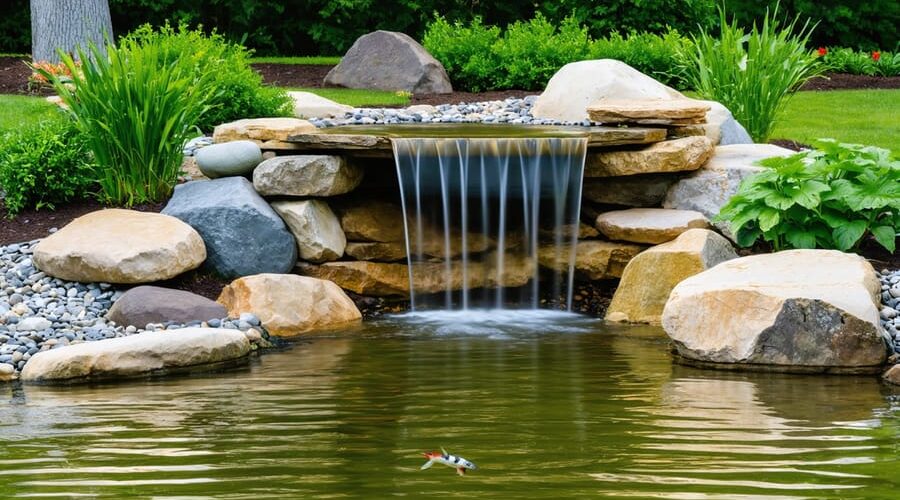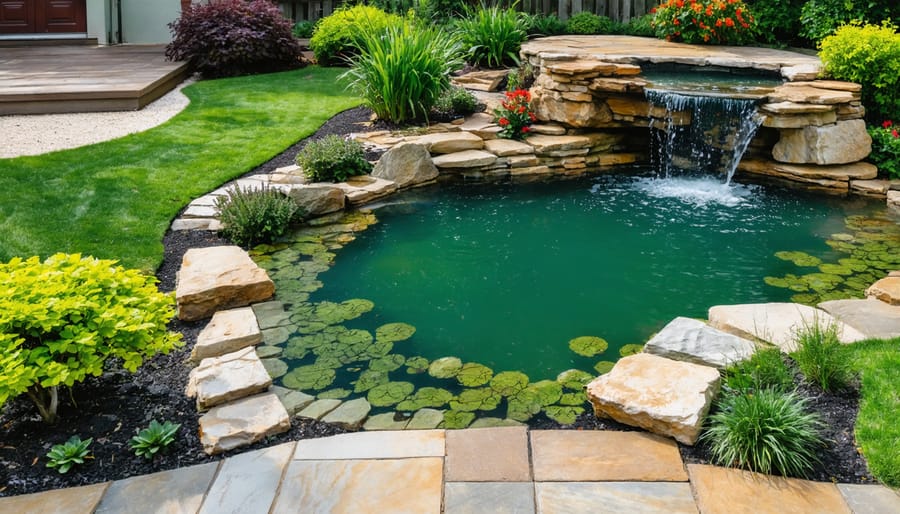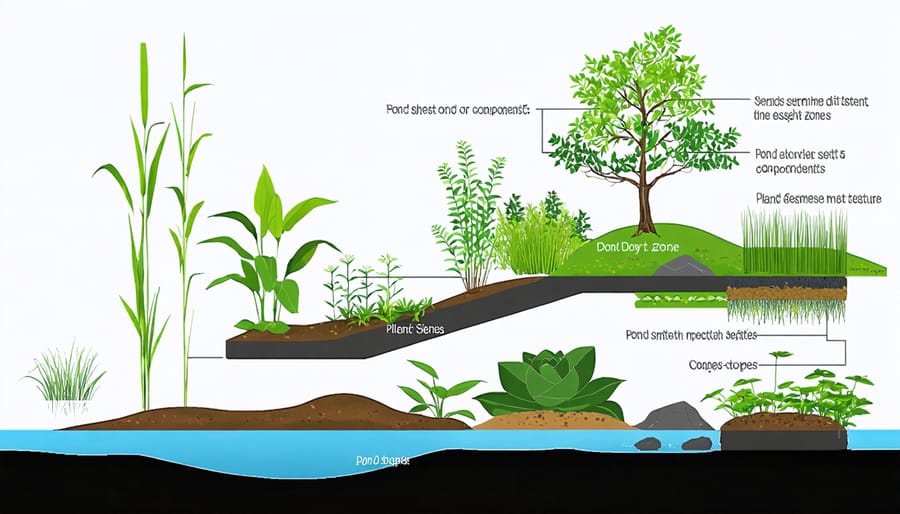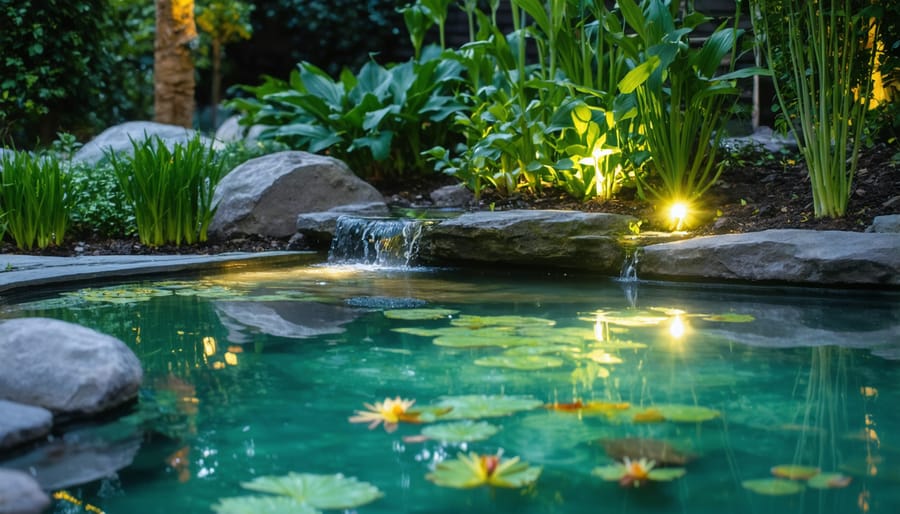
Transform Your Backyard Into a Paradise: Home Pond Design That Works
Transform your backyard into a serene oasis by designing a custom pond that perfectly balances natural beauty with practical functionality. Whether you seek a minimalist meditation pool or an elaborate ecosystem teeming with koi and water lilies, finding the right design inspiration for backyard ponds sets the foundation for success. Strategic placement maximizes visual impact while considering essential factors like sunlight exposure, natural drainage patterns, and existing landscape features. The key elements of exceptional pond design – proper depth variations, integrated filtration systems, and thoughtfully planned edges – work together to create a sustainable aquatic environment that requires minimal maintenance. By incorporating both hard and soft landscaping elements, from natural stone waterfalls to carefully selected marginal plants, your pond becomes a living canvas that evolves with each season while providing a peaceful retreat steps from your door.
Planning Your Perfect Pond Location

Site Assessment Essentials
Before breaking ground on your pond project, a thorough site assessment is crucial for success. Start by examining your yard’s natural slope and drainage patterns during rainfall. This helps you identify potential water collection areas and avoid flooding issues. Walk your property with a level tool to determine high and low points.
Next, contact your local utilities company to mark underground lines – this is often a free service and prevents costly accidents. Consider factors like proximity to trees (roots can damage liners) and exposure to sunlight (most water plants need 4-6 hours daily).
Test your soil type by performing a simple jar test: mix soil with water in a clear container and let it settle. Sandy soil may require extra reinforcement, while clay soil provides natural water retention. Also, check local building codes and HOA restrictions regarding pond construction.
Evaluate accessibility for maintenance and consider views from different angles of your property. The ideal location should be visible from your favorite outdoor sitting areas while maintaining a safe distance from your home’s foundation.
Design Integration with Your Home
Your pond should harmonize with your home’s architectural style and existing landscape design. For a modern home, consider clean lines and geometric shapes, perhaps with concrete edges and minimal plantings. Traditional homes pair beautifully with naturalistic ponds featuring curved edges and abundant water plants.
Match your pond’s materials to your home’s exterior elements. If your house has brick accents, incorporate similar colored stone in your pond’s edging. For homes with wooden features, consider using natural stone or wooden decking around the water feature.
Position your pond where it can be viewed from key areas like living rooms or outdoor seating spaces. Consider sight lines from windows and patios to create engaging views. The sound of flowing water should complement, not overwhelm, your outdoor living areas.
Scale is crucial – a tiny pond might look out of place next to a large home, while an oversized water feature could overwhelm a modest garden. Balance your pond size with your yard’s dimensions and your home’s proportions.
Remember to integrate existing landscaping by extending current garden beds around your pond and using similar plants to create a cohesive look.
Essential Design Elements
Size and Depth Considerations
When planning your home pond, size and depth are crucial factors that directly impact its success and maintenance requirements. For a typical backyard pond, aim for a minimum surface area of 50 square feet to maintain a stable ecosystem. Smaller ponds can work but require more frequent maintenance and careful monitoring.
Depth requirements vary depending on your goals and climate. For fish-keeping, especially koi, maintain at least 4 feet of depth in some areas to provide safe zones during extreme weather and protection from predators. In warmer regions, 2-3 feet might suffice for ornamental ponds without fish.
Consider your yard’s proportions when determining pond size. A good rule of thumb is to make your pond about 20% of your available landscaping space to create visual balance. However, don’t let a small yard discourage you – even a 6×8 foot pond can create a stunning water feature.
Remember to include different depth zones in your design. Include shallow shelves (6-12 inches) for marginal plants, medium depths (12-24 inches) for water lilies, and deeper areas for fish. These varying depths create natural-looking transitions and support diverse aquatic life.
Always check local building codes before starting, as some areas require permits for ponds exceeding certain dimensions or depths. Factor in your maintenance comfort level – larger ponds are more stable but require more significant initial investment and maintenance effort.

Edge and Border Design
The edges and borders of your pond play a crucial role in both aesthetics and functionality. Natural-looking transitions create a seamless blend between your water feature and the surrounding landscape. Consider using graduated shelves along the edges, which not only provide stability but also create different planting zones for aquatic plants.
For a polished look, try incorporating flat stones or pavers that slightly overhang the water. This design element not only looks attractive but also helps hide pond liner edges and provides convenient access points for maintenance. If you’re aiming for a more natural appearance, arrange rocks of varying sizes around the edge, positioning them to create small coves and irregular shapes that mimic nature.
Creating a beach-like entry point on one side of your pond adds visual interest and provides safe access for wildlife. Mix different sizes of gravel and pebbles to achieve this effect. For added safety and stability, install underlayment fabric beneath rocks to protect your pond liner from punctures.
Consider incorporating bog gardens or shallow marshy areas along the edges. These transitional zones not only look beautiful but also support beneficial microorganisms and provide natural filtration. Plant marginal species like iris and rushes in these areas to soften the pond’s edges and create a lush, established look.
Remember to leave some areas with clear access for maintenance and viewing. Strategic placement of stepping stones or a small deck can create perfect spots for enjoying your pond while maintaining its natural appearance.
Water Feature Integration
Adding water features to your pond creates a dynamic and engaging landscape that delights both eyes and ears. Waterfalls are particularly popular, offering the soothing sound of cascading water while helping to aerate your pond naturally. When designing a waterfall, consider starting with a height of 18-24 inches for a modest pond – this provides enough splash without overwhelming the space.
Fountains offer another fantastic option, particularly for smaller ponds. They come in various styles, from simple spray patterns to elaborate tiered designs. Besides their aesthetic appeal, fountains help prevent water stagnation and can deter mosquitoes from breeding. Place them where they’ll be visible from your favorite viewing spots, like a patio or kitchen window.
Streams create a natural transition between different areas of your garden while adding movement to your water feature. Design them with gentle curves rather than straight lines, and incorporate small rapids or mini-falls along the way. Use varying sizes of rocks and pebbles to create a realistic streambed, and don’t forget to add plants along the banks for a naturalistic look.
When integrating these features, remember that proper pump sizing is crucial. A good rule of thumb is to circulate your pond’s entire volume once every hour. Also, consider installing lighting around your water features to create magical nighttime displays and extend your enjoyment into the evening hours.
Practical Design Features
Filtration and Circulation
A well-functioning pond filtration systems is the heart of any healthy water feature. For most home ponds, you’ll need both mechanical and biological filtration to keep the water crystal clear and your fish healthy. The mechanical filter removes debris like leaves and dirt, while biological filtration helps break down harmful waste products using beneficial bacteria.
Circulation is equally important – aim to pump your entire pond volume through the filter once every 1-2 hours. Choose a pump that’s powerful enough for your pond size but energy-efficient for daily operation. Position your pump at the deepest point and create a gentle flow that reaches all areas of the pond.
Consider installing a skimmer to catch floating debris before it sinks, and a UV clarifier to control algae growth. For the best results, hide your filtration equipment behind rocks or plants while ensuring easy access for maintenance. Remember to clean your filters regularly and check pump operation – healthy circulation means happy fish and clear water year-round.
Lighting Solutions
The right lighting can transform your pond from a daytime feature into a magical nighttime display. Strategic illumination not only enhances the beauty of your water garden but also provides practical benefits for evening enjoyment and safety. When exploring pond lighting options, consider starting with underwater lights to highlight special features like fountains or waterfalls. LED spotlights are energy-efficient choices that can be positioned along the pond’s edge to create dramatic shadows and reflections on the water’s surface.
Solar-powered lights offer an eco-friendly solution and eliminate the need for complex wiring, though they may provide less consistent illumination. For a more subtle approach, try floating lights or small pathway markers around the pond’s perimeter. Don’t forget to illuminate any walking paths near your pond for safety. You can create different moods by using warm white lights for a natural feel or colored lights for special occasions. Remember to use waterproof fixtures rated for outdoor use, and consider installing a timer to automate your lighting schedule.

Maintenance Access Points
When designing your pond, incorporating easy-access points will make future maintenance a breeze. Start by including a flat, stable perimeter around the pond’s edge that’s at least 2 feet wide. This walkway allows you to reach all areas of the pond safely while performing routine tasks like cleaning or plant care.
Consider installing stepping stones or platforms that extend slightly into the pond, giving you better access to deeper areas. These should be sturdy and level to prevent accidents during maintenance work. If your pond includes a waterfall or stream, ensure there’s a clear path to reach pump equipment and filtration systems.
For larger ponds, think about creating dedicated maintenance zones where you can easily access underwater components. Installing a bottom drain with nearby access points makes it simpler to perform water changes and remove debris. Remember to position electrical outlets within reach but safely away from water splash zones.
Keep plants in removable containers or baskets rather than planting directly in the pond bottom. This makes it easier to lift them out for pruning or division. Leave enough space between aquatic plants to maneuver cleaning tools without damaging the vegetation.
Plant and Fish Considerations
Plant Zones and Shelves
A well-designed pond should include different planting zones to accommodate various aquatic plants, each adding its own charm to your water garden. Start by creating a shallow shelf around the pond’s edge, about 2-4 inches deep, perfect for marginal plants like iris and rushes. These plants help naturalize the pond’s edges and provide essential cover for wildlife.
Next, build a second shelf 6-12 inches deep for shallow-water plants such as water lilies and lotus. These plants not only add stunning visual interest but also help shade the water, reducing algae growth. For deeper-water plants, incorporate a shelf that’s 12-18 inches below the surface.
When designing these zones, think about accessibility for maintenance and the visual balance of your pond. Shelves should be wide enough to hold planting baskets securely – typically 12-18 inches wide. Consider using flat stones or preformed shelves to create stable platforms for your plant containers.
Remember to vary the depth and width of your shelves to create a more natural look. This stepped approach not only provides ideal growing conditions for different plant species but also adds crucial safety features to your pond design.
Fish-Friendly Features
Creating a fish-friendly pond environment requires careful attention to several key design elements. When designing for koi fish or other pond species, depth is crucial – aim for at least 4 feet in some areas to provide temperature stability and protection from predators.
Include varying depths throughout your pond to create different zones that accommodate various fish behaviors. Shallow areas (1-2 feet) serve as warming spots and feeding zones, while deeper sections offer safety and comfort during extreme weather conditions.
Add plenty of rocks and plants to provide hiding spots and shelter. These natural features not only protect your fish from predators but also create breeding areas and territories. Floating plants offer additional shade and help maintain water quality by absorbing excess nutrients.
Consider installing an aeration system to maintain healthy oxygen levels, especially in deeper areas. A properly sized pump should circulate the entire pond volume at least once every two hours. Include a skimmer and bottom drain to remove debris and maintain water clarity.
Remember to avoid sharp edges or rough surfaces that could harm your fish. Smooth liner materials and rounded stones create a safer environment for your aquatic friends while maintaining an attractive appearance.
Creating your perfect backyard pond is an exciting journey that combines artistic vision with practical know-how. We’ve explored essential elements from selecting the ideal location and size to choosing the right materials and incorporating natural elements. Remember that successful pond design is about finding the right balance between aesthetics and functionality, ensuring your water feature becomes a sustainable ecosystem that brings joy for years to come.
Whether you’re dreaming of a small meditation pond or an elaborate ecosystem with waterfalls and fish, the key is to start with a solid plan and take it one step at a time. Don’t be afraid to get creative with your design while keeping maintenance requirements in mind. Your pond can become a stunning focal point that not only enhances your property’s value but also creates a peaceful retreat right in your backyard.
Ready to begin your pond project? Start by sketching your ideas, measuring your space, and gathering the necessary materials. With proper planning and attention to detail, you’ll soon be enjoying the soothing sounds of flowing water and the vibrant life that your pond brings to your outdoor space.
